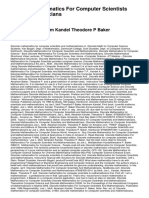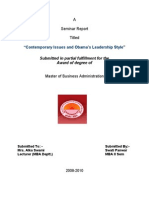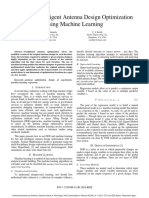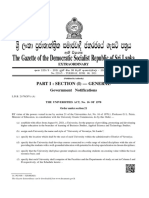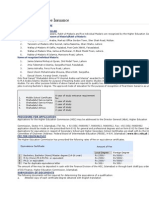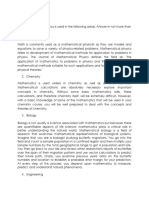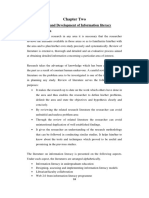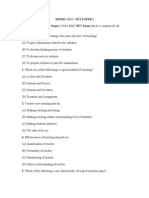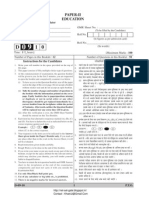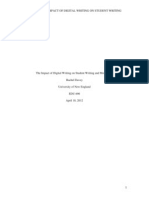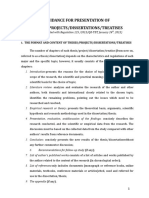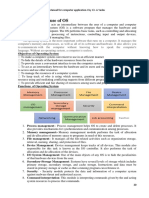Rene Descartes Eng
Rene Descartes Eng
Uploaded by
zaknjige122Copyright:
Available Formats
Rene Descartes Eng
Rene Descartes Eng
Uploaded by
zaknjige122Copyright
Available Formats
Share this document
Did you find this document useful?
Is this content inappropriate?
Copyright:
Available Formats
Rene Descartes Eng
Rene Descartes Eng
Uploaded by
zaknjige122Copyright:
Available Formats
Rene Descartes
Ren
Descartes (French
pronunciation: [ne
dekat]; Latinized form: Renatus
Cartesius; adjectival form: "Cartesian";[3] 31 March 1596 11 February 1650) was a French philosopher, mathematician, and writer who spent most of his adult life in the Dutch Republic Descartes' influence in mathematics is equally apparent; the Cartesian coordinate system allowing algebraic equations to be expressed as geometric shapes in a two-dimensional coordinate system was named after him. He is credited as the father of analytical geometry, the bridge between algebra and geometry, crucial to the discovery of infinitesimal calculus and analysis. Descartes was also one of the key figures in the Scientific Revolution and has been described as an example of genius. Biography Ren Descartes was born on March 31st, 1596 in the town of La Haye in the south of France, the son of Joachim Descartes, a Councilor in Parliament and and intellectual who made certain to provide a good learning environment for his son. In 1606, at the age of 8, Ren attended the Jesuit college of Henri IV in La Flche, where he studied literature, grammar, science, and mathematics. In 1614, he left La Flche to study civil and cannon Law at Poitiers. In 1616, he received his baccalaureate and licentiate degrees in Law. Aside from his Law degrees, Descartes also spent time studying philosophy, theology, and medicine. After a short stay in the military, Descartes went on to lead a quiet life, continuing his intellectual pursuits, writing philosophical essays, and exploring the world of science and mathematics. In 1637, he published "geometry", in which his combination of algebra and geometry gave birth to analytical geometry, better known as Cartesian geometry. But the most important contribution Descartes made were his philosophical writings; Descartes, who was convinced that science and mathematics could be used to explain everything in nature, was the first to describe the physical universe in terms of matter and motion, seeing the universe a as giant mathematically designed engine. Descartes wrote three important texts: Discourse on the Method of Rightly Conducting the Reason and Seeking Truth in the Sciences, Meditations on First Philosophy, and Principles of Philosophy. Ren Descartes had always been a frail individual, and he would usually spend most of his mornings in bed, where he did most of his thinking, fresh from dreams in which he often had his revelations. In his latter years, Descartes had to relocate to Sweden to tutor Queen Christina in philosophy. Unfortunately, the Queen was an
early riser who wanted her lessons at 5:00 o'clock in the morning. This new schedule did not help Descartes fragile health, and he contracted pneumonia, from which he died on February 11, 1650 at the age of 54.
Mathematical legacy
One of Descartes' most enduring legacies was his development of Cartesian or analytic geometry, which uses algebra to describe geometry. He "invented the convention of representing unknowns in equations by x, y, and z, and knowns by a, b, and c". He also "pioneered the standard notation" that uses superscripts to show the powers or exponents, for example the 4 used in x4 to indicate squaring of squaring.[37] He was first to assign a fundamental place for algebra in our system of knowledge, and believed that algebra was a method to automate or mechanize reasoning, particularly about abstract, unknown quantities. European mathematicians had previously viewed geometry as a more fundamental form of mathematics, serving as the foundation of algebra. Algebraic rules were given geometric proofs by mathematicians such as Pacioli, Cardan, Tartaglia and Ferrari. Equations of degree higher than the third were regarded as unreal, because a three dimensional form, such as a cube, occupied the largest dimension of reality. Descartes professed that the abstract quantity a2 could represent length as well as an area. This was in opposition to the teachings of mathematicians, such as Vieta, who argued that it could represent only area. Descartes work provided the basis for the calculus developed by Newton and Leibniz, who applied infinitesimal calculus to the tangent line problem, thus permitting the evolution of that branch of modern mathematics. His rule of signs is also a commonly used method to determine the number of positive and negative roots of a polynomial. Descartes discovered an early form of the law of conservation of mechanical momentum (a measure of the motion of an object), and envisioned it as pertaining to motion in a straight line, as opposed to perfect circular motion, as Galileo had envisioned it. He outlined his views on the universe in his Principles of Philosophy. Descartes also made contributions to the field of optics. He showed by using geometric construction and the law of refraction (also known as Descartes's law or more commonly Snell's law, who discovered it 16 years earlier) that the angular radius of a rainbow is 42 degrees (i.e., the angle subtended at the eye by the edge of the rainbow and the ray passing from the sun through the rainbow's centre is 42).He also independently discovered the law of reflection, and his essay on optics was the first published mention of this law. Although Descartes was well known in academic circles towards the end of his life, the teaching of his works in schools was controversial. Henri de Roy (Henricus Regius, 15981679), Professor of Medicine at the University of Utrecht, was condemned by the Rector of the University, Gijsbert Voet (Voetius), for teaching Descartes's physics.
You might also like
- EXAMEN - MENDIX - PROok - 03 OkDocument21 pagesEXAMEN - MENDIX - PROok - 03 OkMendez Hernandez Emanuel100% (1)
- CV Most. Ashrafi Jahan NewDocument3 pagesCV Most. Ashrafi Jahan Newashrafipinki91% (11)
- BES Formal Lesson Plan: Curriculum Crafter First Grade Common Core Math Math CCSS First Grade Saxon MathDocument3 pagesBES Formal Lesson Plan: Curriculum Crafter First Grade Common Core Math Math CCSS First Grade Saxon Mathapi-255748272No ratings yet
- Problems Faced by Female Teachers in Teaching Geography at Secondry Level in District Peshawar1Document41 pagesProblems Faced by Female Teachers in Teaching Geography at Secondry Level in District Peshawar1muneeba khanNo ratings yet
- Discrete Mathematics For Computer Scientists and MathematiciansDocument2 pagesDiscrete Mathematics For Computer Scientists and MathematiciansSoni chauhan100% (1)
- Algebra DBQDocument11 pagesAlgebra DBQapi-276032836No ratings yet
- UCD MSC Space Science and Technology BrochureDocument2 pagesUCD MSC Space Science and Technology BrochureBryan RodgersNo ratings yet
- Unlicensed EngineerDocument2 pagesUnlicensed EngineerAbdul Rafay100% (1)
- The Relationship Between Mathematics and Science Process SkillsDocument1 pageThe Relationship Between Mathematics and Science Process SkillszatulfahimaNo ratings yet
- Monash Science Chemistry Brochure 2015Document2 pagesMonash Science Chemistry Brochure 2015MonashscienceNo ratings yet
- Maths Book LinkDocument1 pageMaths Book LinkAjay PandeyNo ratings yet
- Chapter 2 Summary and Learning InsightsDocument1 pageChapter 2 Summary and Learning InsightsRichel Borres MangmangNo ratings yet
- Seminar Report On ObamaDocument22 pagesSeminar Report On Obamaswati1004No ratings yet
- 2018 CBPSME BrochureDocument2 pages2018 CBPSME BrochureAlKennethLabasenNo ratings yet
- Fast and Intelligent Antenna Design Optimization Using Machine LearningDocument2 pagesFast and Intelligent Antenna Design Optimization Using Machine LearningDivyanshu BoseNo ratings yet
- Gazette On University of Vavuniya 2021-06-09Document2 pagesGazette On University of Vavuniya 2021-06-09Adaderana OnlineNo ratings yet
- 8624 2... AssignmentDocument28 pages8624 2... AssignmentMuhammad Adnan ShakeelNo ratings yet
- Chirag ResumeDocument2 pagesChirag ResumeSai SaurabNo ratings yet
- Discovered QuestionsDocument112 pagesDiscovered QuestionsKanan Gupta100% (1)
- Equivalence Degree IssuanceDocument2 pagesEquivalence Degree IssuanceHumaira ShafiqNo ratings yet
- Module 1 3.1Document2 pagesModule 1 3.1zoeNo ratings yet
- Linear Algebra (Math1014) Course OutlineDocument14 pagesLinear Algebra (Math1014) Course OutlinencisisthebestNo ratings yet
- 20131119111156week 1 - Intro To Educational ResearchDocument65 pages20131119111156week 1 - Intro To Educational Researchnadi_ashaNo ratings yet
- Workplace Education ProjectDocument2 pagesWorkplace Education Projectmay563265No ratings yet
- DBall DissertationDocument271 pagesDBall DissertationBharathFrnzbookNo ratings yet
- 8611 Assignment (2) Iqra Lateef 0000046493Document29 pages8611 Assignment (2) Iqra Lateef 0000046493iqraNo ratings yet
- 08 History and Development of Information LiteracyDocument65 pages08 History and Development of Information LiteracybelzinhaNo ratings yet
- MarketingDocument2 pagesMarketingElmarie BarroNo ratings yet
- UitmDocument2 pagesUitmGiovanni Andrew DaltonNo ratings yet
- UGC NET First Paper Model Questions and Answer KeyDocument14 pagesUGC NET First Paper Model Questions and Answer KeyMuralidhar Dunna100% (1)
- Final Ug TT - r2007Document3 pagesFinal Ug TT - r2007Ramki M RamNo ratings yet
- Huzaifa ThesisDocument82 pagesHuzaifa ThesisHuzaifa SaleemNo ratings yet
- 04 B Ed Fourth SemesterDocument37 pages04 B Ed Fourth SemesterEkta Raje Singh BundelaNo ratings yet
- Cherwell Express Software Manager Installation GuideDocument3 pagesCherwell Express Software Manager Installation GuidejaffNo ratings yet
- 1) NEP 2020 - 01st April 2022Document47 pages1) NEP 2020 - 01st April 2022Allwin Devaraj SNo ratings yet
- 8612 Assignment 1 Ali Faizur RehmanDocument13 pages8612 Assignment 1 Ali Faizur RehmanAli Faizur RehmanNo ratings yet
- Institutions of Higher Learning and Education in Ancient India. Evolution of Higher Learning and Research in Post Independence IndiaDocument93 pagesInstitutions of Higher Learning and Education in Ancient India. Evolution of Higher Learning and Research in Post Independence IndiaUma TNANo ratings yet
- Pedagogy of Science Unit 1Document25 pagesPedagogy of Science Unit 1Melody KhwairakpamNo ratings yet
- Ugc Net Education Paper II Solved D0910Document7 pagesUgc Net Education Paper II Solved D0910Raajkuumar Khatri100% (1)
- Action Research PracticalDocument55 pagesAction Research PracticalshahanaNo ratings yet
- Action Research Project FinalDocument57 pagesAction Research Project Finalapi-136535159No ratings yet
- The Sacraments: Jesus Christ Is The First and Greatest SacramentDocument2 pagesThe Sacraments: Jesus Christ Is The First and Greatest SacramentJasonKimesNo ratings yet
- Research ProposalDocument11 pagesResearch ProposalHuMera U'SafNo ratings yet
- OUTLINE Statistics in EducationDocument5 pagesOUTLINE Statistics in EducationAshiq ShahzadNo ratings yet
- M.SC - Urban Design & Dual Degree (Technical University of Berlin)Document3 pagesM.SC - Urban Design & Dual Degree (Technical University of Berlin)meenuNo ratings yet
- Tariq Javed Education HSR 2017 Mohi Ud Din Islamic Univ AJK 23.11.2017 PDFDocument409 pagesTariq Javed Education HSR 2017 Mohi Ud Din Islamic Univ AJK 23.11.2017 PDFSara YounusNo ratings yet
- Guidance For Presentation of ThesisDocument23 pagesGuidance For Presentation of ThesisJames GajeNo ratings yet
- Egyptian Informatics Journal: F. Sherwani, B.S.K.K. Ibrahim, Muhammad Mujtaba AsadDocument8 pagesEgyptian Informatics Journal: F. Sherwani, B.S.K.K. Ibrahim, Muhammad Mujtaba AsadRobert Maximilian100% (1)
- 1.1 Selecting A TopicDocument5 pages1.1 Selecting A TopicAthamiz SelvanNo ratings yet
- Dr. Arbab Afridi (Method of Teaching English)Document2 pagesDr. Arbab Afridi (Method of Teaching English)Muhammad Nawaz Khan AbbasiNo ratings yet
- Critical Theory: From Michael Apple's Perspective (Review)Document5 pagesCritical Theory: From Michael Apple's Perspective (Review)Johan Fernando Aza Rojas100% (1)
- VargaMeagan Paper 1Document42 pagesVargaMeagan Paper 1Lorenz lingaoNo ratings yet
- Technical and Vocational Education and Training Issues in Malaysia and Asian Region: Where Do We Go From Here?Document11 pagesTechnical and Vocational Education and Training Issues in Malaysia and Asian Region: Where Do We Go From Here?Kamal JasmanNo ratings yet
- Key Terms in Comparative EducationDocument38 pagesKey Terms in Comparative EducationEllen BoerenNo ratings yet
- Purpose of ResearchDocument3 pagesPurpose of ResearchPRINTDESK by DanNo ratings yet
- Rene Descartes A Renowned French Mathematician in The 16th CenturyDocument4 pagesRene Descartes A Renowned French Mathematician in The 16th CenturyTing Sing HoNo ratings yet
- Not Real Rene A Giant Historical FraudDocument5 pagesNot Real Rene A Giant Historical FraudSot SyrNo ratings yet
- Contribution and Implications On SocietyDocument3 pagesContribution and Implications On SocietyNairah DimakutaNo ratings yet
- Descartes and His Coordinate SystemDocument2 pagesDescartes and His Coordinate SystemBavani VaniNo ratings yet
- Early Life: Meditations Defined The Basic Problems of Philosophy For at Least A CenturyDocument4 pagesEarly Life: Meditations Defined The Basic Problems of Philosophy For at Least A Centuryjanina mykaNo ratings yet
- René DescartesDocument3 pagesRené DescartesTon JanabanNo ratings yet
- René DescartesDocument2 pagesRené DescartesEshia RinNo ratings yet
- ASCII Character Codes - PrintableDocument3 pagesASCII Character Codes - PrintableSaad SarwarNo ratings yet
- The Period of A Mass On A SpringDocument16 pagesThe Period of A Mass On A SpringPatrick SibandaNo ratings yet
- Ii Conditional IF + Past Simple +would: Put The Verbs in The Correct FormDocument2 pagesIi Conditional IF + Past Simple +would: Put The Verbs in The Correct FormANDREEA BĂLANNo ratings yet
- Sorting Data: Implement Grep and TarDocument3 pagesSorting Data: Implement Grep and TarSushant MoreNo ratings yet
- City of Malabon UniversityDocument79 pagesCity of Malabon UniversityJamie AustriaNo ratings yet
- Unit 3. Operating SystemDocument7 pagesUnit 3. Operating SystemRaju KumaarNo ratings yet
- Three Rs LPDocument4 pagesThree Rs LPapi-295499140No ratings yet
- Structure RevisionDocument65 pagesStructure RevisionLMAO NooneNo ratings yet
- Checking For Understanding Techniques - 120310Document3 pagesChecking For Understanding Techniques - 120310irmomiddleNo ratings yet
- Representation of Patterns and Classes Lesson 3Document8 pagesRepresentation of Patterns and Classes Lesson 3Aditya RaiNo ratings yet
- Chapter 2Document22 pagesChapter 2Sameer SharmaNo ratings yet
- Advanced Numerical Methods - Q. BDocument12 pagesAdvanced Numerical Methods - Q. BGANESANMECH05No ratings yet
- Jesus:: Our Foundation Rock For EducationDocument56 pagesJesus:: Our Foundation Rock For EducationEnglish BibleNo ratings yet
- Computer Architecture Notes - RanaDocument14 pagesComputer Architecture Notes - Ranarahul_singh654492550% (2)
- g10 Lesson Plan Health q1 w9Document3 pagesg10 Lesson Plan Health q1 w9Romenick CruzNo ratings yet
- Life of Petofi SandorDocument4 pagesLife of Petofi SandorDiana Maria IndriesNo ratings yet
- CSC 301 Sem1 2021-2022 - 2 Data Structures IDocument99 pagesCSC 301 Sem1 2021-2022 - 2 Data Structures INkembeh Benjamin SC20C092No ratings yet
- William Quan Judge - Questions and AnswersDocument28 pagesWilliam Quan Judge - Questions and AnswerskPodNo ratings yet
- January 2013Document4 pagesJanuary 2013Aamader MaldaNo ratings yet
- EEE305 Part04Document56 pagesEEE305 Part04qwertNo ratings yet
- New GuineaDocument3 pagesNew GuineaCarl PhilipNo ratings yet
- Sample Paper Class XIDocument5 pagesSample Paper Class XIchupkarjaoyaarNo ratings yet
- Camlab (PDF Library)Document4 pagesCamlab (PDF Library)Milan RamaniNo ratings yet
- Linux Tutorial - 9. Discover FiltersDocument15 pagesLinux Tutorial - 9. Discover Filtersaksljklasjdlkas ksjdsNo ratings yet
- BCS452 - Object Oriented Programming With Java LabDocument3 pagesBCS452 - Object Oriented Programming With Java LabMohit ChowdharyNo ratings yet
- CE 199 Form 5 A Rating System For Thesis Defense B 1Document2 pagesCE 199 Form 5 A Rating System For Thesis Defense B 1mariequilamanNo ratings yet
- Deleting Old History Files On The As 400Document2 pagesDeleting Old History Files On The As 400rachmat99No ratings yet
- My Name Is Israel Yk Lubogo Symphony of Determination TRDocument8 pagesMy Name Is Israel Yk Lubogo Symphony of Determination TRlubogoNo ratings yet




